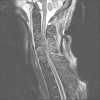Diagnosis and prognosis of traumatic spinal cord injury
- PMID: 24353930
- PMCID: PMC3864437
- DOI: 10.1055/s-0031-1296049
Diagnosis and prognosis of traumatic spinal cord injury
Abstract
Despite promising advances in basic spinal cord repair research, no effective therapy resulting in major neurological or functional recovery after traumatic spinal cord injury (tSCI) is available to date. The neurological examination according to the International Standards for Neurological and Functional Classification of Spinal Cord Injury Patients (International Standards) has become the cornerstone in the assessment of the severity and level of the injury. Based on parameters from the International Standards, physicians are able to inform patients about the predicted long-term outcomes, including the ability to walk, with high accuracy. In those patients who cannot participate in a reliable physical neurological examination, magnetic resonance imaging and electrophysiological examinations may provide useful diagnostic and prognostic information. As clinical research on this topic continues, the prognostic value of the reviewed diagnostic assessments will become more accurate in the near future. These advances will provide useful information for physicians to counsel tSCI patients and their families during the catastrophic initial phase after the injury.
Keywords: diagnosis; prognosis; review; spinal cord injury.
Figures



References
-
- National Spinal Cord Injury Statistical Center (SCISC). The 2008 annual statistical report for the spinal cord injury model systems. Available at: https://www.nscisc.uab.edu/public_content/pdf/2008%20NSCISC%20Annual%20S.... Accessed February 2010
-
- Wyndaele M, Wyndaele JJ. Incidence, prevalence and epidemiology of spinal cord injury: what learns a worldwide literature survey? Spinal Cord. 2006;44:523–529. - PubMed
-
- Norton L. Spinal Cord Injury, Australia 2007–08. Injury Research and Statistics Series No. 52. Cat No. INJCAT 128. Canberra, Australia: AIHW; 2010
-
- van Middendorp JJ Hosman AJ Pouw MH Van de Meent H; EM-SCI Study Group. Is determination between complete and incomplete traumatic spinal cord injury clinically relevant? Validation of the ASIA sacral sparing criteria in a prospective cohort of 432 patients Spinal Cord 200947809–816. - PubMed
-
- Lopez AD Mathers CD Ezzati M Jamison DT Murray CJL, eds. Global Burden of Disease and Risk Factors. New York: Oxford University Press; 2006
LinkOut - more resources
Full Text Sources
Medical
Research Materials

